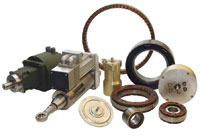
Posted to News on 7th Aug 2012, 00:00
Servo system design
Designing and building servo motion systems remains a black art to many engineers, but an understanding of a few some fundamental principles will help with the initial stages of a project. David Baillie of HT Servo shares his expertise.

>In many fields of engineering, standardisation and classification have created a logical process that allows engineers follow a defined procedure and design effective systems. One example of this is industrial drives, where induction motors are available in standard frames sizes and powers (and in a number of special formats, such as washdown, high efficiency and explosion proof). In the vast majority of cases, it is possible to design a drive system using standard motors, and knowing that motors from different manufacturers are largely interchangeable.
>Precision motion and servo motor design has not yet reached this stage. There are still many manufacturers, most of whom offer a very wide range of motor designs - some clearly definable as weird and wonderful. There is a trend towards rationalisation, with many of the smaller manufacturers amalgamating into larger groups and rationalising their product offerings. But because servo motors will always be at the leading edge of engineering developments, there will never be full standardisation.
>There is an increasing need for servo systems, as more and more precision motion is being called for in robots, production machinery, packaging machines, food processing, medical equipment, consumer goods, and more. Many designers will choose to bring in a specialist colleague for servo work, but it is good practice to have a grasp of the basics. There are many types of motor to choose from, including brushed or brushless and AC or DC. And of course there are non-servo options, such as stepper motors and vector controlled induction motors. Selecting the best type of motor is often one of the two most daunting part of servo system design. Looking at all the options from half a dozen manufacturers' catalogues or websites can be totally bewildering, but two good ideas are to follow the preferences of your particular industry or application and to take the advice of a servo expert.
>In industrial applications, motor size selection is based on some simple load and speed calculations. But servo motor calculations are often based on inertia and seem far more complicated. This is because industrial motors tend to run at constant speed, with acceleration and deceleration being virtually ignorable parts of the duty cycle. But in servo systems acceleration and deceleration form a much larger part of the cycle, they must be under perfect control and are often extreme in order to effect a significant speed change in a tiny time frame.
>Servo selection can seem even harder because the duty cycle may be complicated, involving say four or five separate accelerations, as many decelerations, several different fixed speed periods and variable loads and timings. However, the calculation procedure is simply to break the motion profile down to its component steps and work through each one in turn. The thing to remember here is that the servo motor chosen has to be adequate for the biggest step in the cycle. Most manufacturers now have on-line calculators. To use a calculator you just follow the instructions and insert the parameters of your application; it does the calculations and recommends suitable motor sizes and types.
>Machine design trends
>Trends in machine design include reducing component (including motor) size and increasing power requirements. Servo motor makers are responding to both of these, but it is worth noting that more powerful motors often need higher supply voltages, so multi motor systems may need multiple power supplies. Some manufacturers offer power supplies that can provide two or more voltages. High performance motors can prove unreliable, usually because the higher voltage increases heat output which degrades the critical insulation. The better motors will tend to have high quality insulation and potted stators for good heat dissipation. It is also worth checking a motor's seals, as servo environments can be quite demanding. The obvious things to consider are ingress of dirt, dust and water/moisture, but seals also work to contain particulates produced by brush wear which could be a major issue in clean room or sterile applications.
>Servo motors are always used with servo amplifiers. They are always supplied as a matched pair, so by specifying the motor, selection of the amp becomes a resolved issue. It is a common design solution to ask a manufacturer to customise a standard motor with a bespoke shaft or bearings.
>Motor mounting issues do not represent the exciting end of servo design, but the fact that there are 50-100 mounting standards suggests that it is a very important matter. Servo motors may accelerate at incredible speeds, so must be securely mounted. They also need isolation to reduce vibration, noise and associated damage. Then there are safety standards and myriad national standards. You may also need to accommodate a bearing, gearbox, brake or other component. Sound advice here is to ask the supplier - they will probably offer a solution promptly based on their years of experience. And that is certainly preferable to wading through the options yourself.
>Servo motors can provide full torque at zero speed, that is to say they can be electrically locked down or parked. However, a mechanical brake should be specified when an axis needs to be held or stopped without servo control. The most common application is a vertical axis driven with a ballscrew or another mechanism that can drop when the servo is not energised. Brakes are generally fail-safe devices, so are mechanically engaged when the power is off, and are not intended for repetitive dynamic use. An additional external brake must be used for dynamic braking.
>Servos are always used in closed-loop configuration - the second daunting part of servo system design and here we will cover only the basics. A 'sensor' constantly monitors the position of the motor shaft to a high degree of accuracy and time resolution. This data is fed back to the amplifier to keep the motor running with assured precision. Typical sensors are - in increasing order of cost and performance - resolvers, incremental encoders, sine encoders and 'intelligent devices'. Some motor types need specific feedback technologies; sometimes the application determines whether it is speed, position, rotational or linear measurement that is required. Designing the best feedback configuration can be difficult and involves calculating resolutions, time signatures, selecting the most appropriate hardware and usually some fairly intense on-site tuning.
>In conclusion, servo systems provide the ultimate in power and accuracy of any motion technology. While they are becoming easier to specify, install and use, the best results will always be attained when expert advice is followed.








